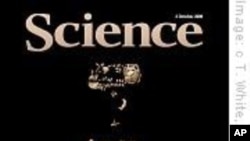Anthropologists from around the world have added another million or so years to the history of human evolution. Scientists say the latest fossil find - while not a direct ancestor of modern humans, may offer new insights into the primate family tree.
At 4.4 million years of age, Ardipithecus ramidus, which scientists have nicknamed Ardi, is now the oldest skeleton of a human ancestor since the discovery of Lucy, the 3.2 million-year-old female hominid skeleton discovered in Ethiopia in 1974.
Until now, Lucy was believed to have shared a common ancestor with prehistoric apes and to have evolved from there.
But scientists say their new analysis of the older Ardipithecus skeleton suggests that chimps and humans evolved separately from an even older common relative.
Owen Lovejoy is a professor of Anthropology at Kent State University's Biomedical Sciences division in Ohio.
"This was like discovering a time capsule from a period and a place that we knew nothing about," Lovejoy said.
It took anthropologists 17 years to assemble and analyze multiple skull, hand, feet, limb and pelvis fragments of Ardipithecus, which were first discovered in ancient lake and stream deposits near the Ethiopian village of Aramis in 1992.
Researchers say the composite skeleton belonged to an adult female who stood 120 centimeters, or four feet tall and weighed about 50 kilograms.
Ardi had elongated palms and special joints and ligaments that allowed it to climb and hang from tree branches. Its bone structure also permitted walking upright on the ground like modern humans. But it lacked the arched feet and smooth gait evident in Lucy and other later hominids.
Researchers say that despite its many ape-like features, Ardipithecus was too different from modern chimps for the lineage to be considered direct.
Scientists note that Ardi's upper canine teeth are more like the stubby ones of modern humans than the long, sharp, pointed ones of male chimps and other primates. A scientific analysis of the tooth enamel suggests Ardi enjoyed a diet of fruit and other woodland-based foods such as nuts and leaves.
Tim White, a professor at the Human Evolution Research Center at the University of California at Berkeley says Ardipithecus' mixture of ape and human-like features suggests that our "last common ancestor" may have been much older than anthropologists believe.
"We may have thought that human evolution began somewhat by accident a million years ago with the discovery of tools or 2.5 million years ago with the discovery of the first stone tools," White said. "But in fact, Ardipithecus tells us that we as humans have been evolving toward what we are today for at least six million years."
Scientists say they need more fossil finds dating back three to five million years to determine whether Ardipithecus might be even more closely related to early humans than the current evidence suggests.
Ethiopia regards Ardi's fossil remains as a national treasure, and they are on permanent display at the anthropology museum in Addis Ababa.
The discovery of Ardipithecus is detailed in 11 research papers published this week in the journal Science.






